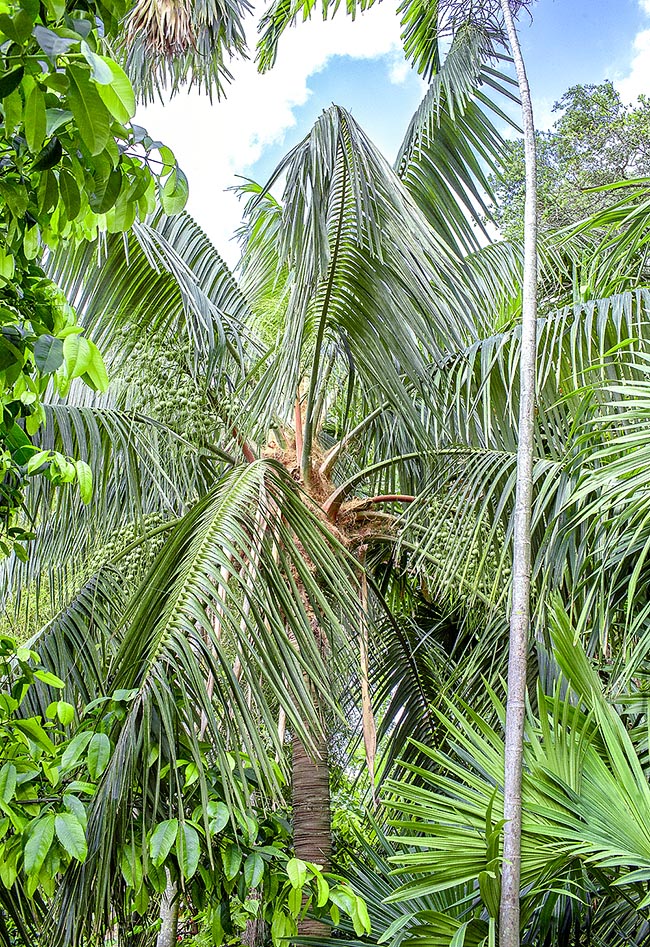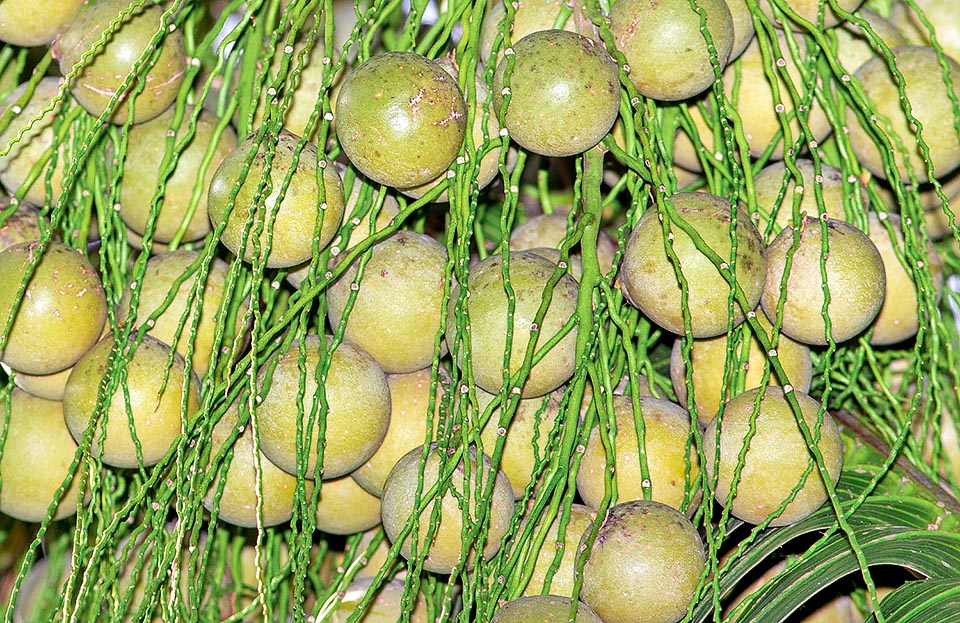Family : Arecaceae

Text © Pietro Puccio

English translation by Mario Beltramini

Orania palindan is native to Philippines, Moluccas, New Guinea and Sulawesi where it reaches the height of 10 m © Giuseppe Mazza
The species is native to the Moluccas, New Guinea, Philippines (Luzon and Sibuyan) and Sulawesi where it grows in the humid forests from the sea level up to about 800 m of altitude.
The genus was dedicated to the Prince Willem van Oranje Nassau (1792-1849), later King William II of the Netherlands; the name of the species is one of those used in the Philippines.
Common names: (English): ambobanga, banga, bunga, palindan (Philippines); ajabu, ifo-ifo, nibun kelapa hutan, saser (New Guinea).
The Orania palindan (Blanco) Merr. (1905) is an unarmed monoecious species, up to about 10 m tall, with erect solitary stem, of 25-30 cm of diameter, smooth, greyish, on which are visible the rings trace of the junction of the fallen leaves. The leaves, on a 1-1,5 m long petiole covered by reddish brown tomentum, are paripinnate, 5-6 m long, with 50-65 pairs of leaflets regularly arranged along the rachis, drooping, 1,3-1,8 m long and 5-8 cm broad in the central part, linear lanceolate with irregularly toothed apex, truncated at the apex and toothed in the terminal ones, coriaceous, of pale green colour and glossy above, covered by a thick white tomentum below. The foliar base, 40-60 cm long, with fibrous margins and covered by a brown red tomentum externally, wraps only partially the stem in the most external leaves. The inflorescences, initially enclosed in a woody bract: generate between the leaves (interfoliar), 1-2 m long, with ramifications of second order and numerous rachillae, 25-60 cm long, bearing unisexual flowers united in groups of three (one female flower between two male), but in the terminal part where are present only male flowers in pair. Male flowers with calyx having 3 triangular lobes, 3 free petals and 6 stamens, similar female flowers with 6 staminodes, tri-carpellate gynaeceum and trilobed stigma. Spherical fruits, or bilobate, if developped by two carpels, of 5,5-6 cm of diameter, initially green, then yellowish when ripe, globose seeds of 3-4 cm of diameter of reddish brown colour. Parts of the plant are poisonous, in particular the fruits that are therefore to be handled cautiously, possibly wearing gloves.
It propagates by seed, previously kept in water for two days, in rather high containers, seen that the hypocotyl goes very deep, with draining loam rich of humus maintained humid at the temperature of 26-30 °C, with germination times from 1 to 3 months.

The 5,5-6 cm diameter spherical fruits, yellowish when ripe, are venomous and hence must be handled with care, possibly wearing gloves © Giuseppe Mazza
Palm among the most ornamental of the genus due to the elegant foliage, of great effect in parks and gardens as isolated specimen, in group or at the margins of alleys, cultivable exclusively in the tropical and humid subtropical climate regions, not bearing temperatures around the 0 °C, even if for short times. It requires an exposition in full sun when adult, partly shady during the first years of life, and is not particular about the soil, provided draining and maintained almost constantly humid.
The stems, fairly hard, are used in the dwellings and the leaves as cover of rural dwellings.
Synonyms: Caryota palindan Blanco (1837); Orania philippinensis Van Geert. (1882); Orania moluccana Becc. (1885); Orania palindan var. sibuyanensis Merr. (1905); Orania decipiens var. montana Becc. (1919); Orania philippinensis var. sibuyanensis (Merr.) Becc. (1919).
